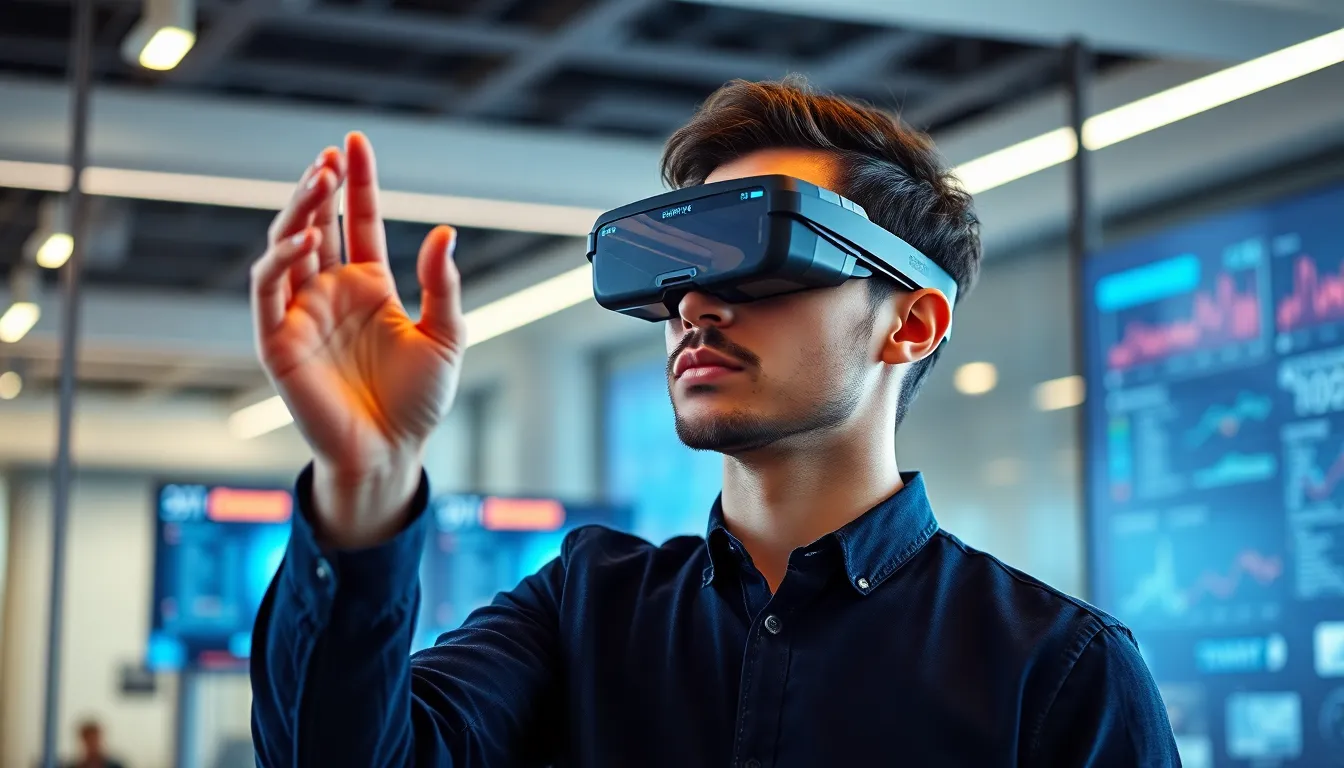Augmented reality isn’t just for sci-fi movies anymore; it’s transforming the way we interact with the world. Imagine walking into a coffee shop and instantly seeing the barista’s recommendations floating in front of you, or trying on a pair of shoes without ever leaving your couch. These aren’t just dreams—they’re the exciting innovations shaping our future.
Table of Contents
ToggleOverview of Augmented Reality Innovations
Augmented reality (AR) innovations continue to reshape how individuals interact with the world. Retailers integrate AR into shopping experiences, allowing customers to visualize products in their own environments. For instance, furniture retailers utilize AR applications, enabling consumers to see how a couch fits within their living rooms before purchasing.
Education benefits significantly from AR advancements. Students engage with interactive simulations, making complex subjects like biology and history more tangible. Medical training programs employ AR technology for surgical simulations, increasing preparation and confidence among future surgeons.
Entertainment industries also leverage AR, delivering immersive experiences through mobile devices and smart glasses. Gamers explore virtual landscapes superimposed on real-world environments, enhancing gameplay and community engagement. Events like concerts and festivals often incorporate AR for interactive experiences, offering attendees unique ways to connect.
Healthcare innovations incorporate AR for improved patient care and treatment planning. Surgeons use AR to overlay critical information during procedures, enhancing precision and outcomes. Similarly, patients access AR tools for understanding treatment options through visual representations.
Marketing strategies shift as brands personalize campaigns using AR. Promotions may include interactive content that draws consumers into experiences, encouraging engagement and brand loyalty. These innovations allow companies to stand out in competitive markets.
The future of AR holds enormous potential across various sectors. Ongoing advancements in hardware and software promise to expand capabilities and accessibility. As AR technology evolves, staying informed about new applications and trends becomes essential for individuals and businesses alike.
Key Technologies Driving Augmented Reality

Understanding the key technologies behind augmented reality (AR) helps gauge its transformative potential. Two significant elements enable the growth of AR: computer vision and wearable devices.
Computer Vision
Computer vision analyzes visual information from the world, allowing devices to interpret and interact with surroundings. This technology aids AR systems in recognizing faces, objects, and environments. It empowers applications like visual search, where users find products through image recognition. Enhanced algorithms for depth perception create seamless overlays, making virtual objects appear realistic. Recognizing spatial features enables precise placement of digital elements over physical spaces. The ongoing advancements in computer vision significantly boost AR’s utility in various sectors.
Wearable Devices
Wearable devices, including smart glasses and headsets, play a vital role in delivering AR experiences. These gadgets offer hands-free interaction, making it easier for users to engage with digital content while keeping their hands available for other tasks. Smart glasses, such as Microsoft HoloLens and Google Glass, utilize high-quality displays to overlay information directly onto users’ fields of view. With built-in sensors and cameras, these devices enable real-time interaction with the environment. Continuous improvements in battery life and processing power enhance the overall user experience. Wearable AR technology becomes central to applications in training, navigation, and entertainment, shaping the future of user interactions.
Applications of Augmented Reality Innovations
Augmented reality innovations transform how industries operate. Multiple sectors leverage AR to enhance user experience and improve operations.
Healthcare
In the healthcare sector, AR significantly enhances patient care. Surgeons utilize AR for surgical training and real-time guidance during procedures. Visual overlays provide critical information, helping them navigate complex anatomy. Medical students engage with interactive simulations, making anatomy concepts easier to grasp. Patients benefit from AR applications that explain procedures in an easy-to-understand manner, improving their overall experience. Numerous hospitals have adopted AR technologies to reduce errors and enhance surgical precision.
Education
Education benefits from augmented reality by fostering interactive learning experiences. Students access immersive simulations that bring complex topics to life. AR tools allow for virtual field trips, letting learners explore historical sites and ecosystems without leaving classrooms. Instructors incorporate AR into lesson plans, facilitating deeper engagement with course material. Many educational institutions report increased student motivation when using AR, highlighting its effectiveness in modern teaching strategies. Engaged students often achieve better learning outcomes, making AR a valuable educational tool.
Retail
Retailers use augmented reality to elevate the shopping experience. Customers visualize products in their environments, enhancing purchase confidence. Many brands offer virtual try-on solutions, allowing shoppers to assess clothing, accessories, and makeup before buying. AR-based marketing campaigns create a personalized shopping experience, increasing customer engagement and loyalty. Reports indicate higher conversion rates when retailers utilize AR features. Businesses that integrate AR into their strategies often see a competitive advantage in the fast-evolving retail landscape.
Future Trends in Augmented Reality
Augmented reality continues to evolve, shaping a promising future across multiple sectors.
Enhanced User Experiences
Enhanced user experiences stand at the forefront of AR’s future. AR applications focus on creating more engaging and interactive environments, enriching daily interactions. Users expect seamless integration into their lives, leading to a rise in AR solutions that personalize experiences. The retail sector increasingly incorporates AR, allowing shoppers to visualize products in real time and making informed decisions. Educational tools strive to immerse students in captivating scenarios, enhancing learning through interactive simulations. Immersive entertainment experiences draw users into captivating storylines, creating memorable moments. As technology advances, the potential for AR to transform everyday activities grows.
Integration with AI
Integration with AI marks a significant trend in AR’s evolution. Intelligent algorithms enhance AR applications by recognizing objects and understanding user preferences in real time. Brands leverage this technology to provide tailored recommendations that resonate with consumers. In healthcare, smart systems use AI to offer real-time insights during complicated procedures, improving outcomes. AI-driven AR tools facilitate more effective training programs for professionals, ensuring they acquire the necessary skills efficiently. Combining these technologies leads to more intuitive user interfaces and improves decision-making processes. The synergy between AR and AI pushes boundaries and fosters innovation across various fields.
Augmented reality is poised to redefine how people interact with the world around them. As its applications expand across various sectors like retail, healthcare, and education, the potential for innovation seems limitless. Users are increasingly drawn to personalized experiences that AR provides, enhancing engagement and satisfaction.
The integration of AI with AR technologies is set to elevate these experiences further, offering smarter solutions that cater to individual preferences. As AR continues to evolve, it promises to create a future where digital and physical realities blend seamlessly, transforming everyday life in exciting ways. The journey of AR is just beginning, and its impact will be felt across generations to come.


